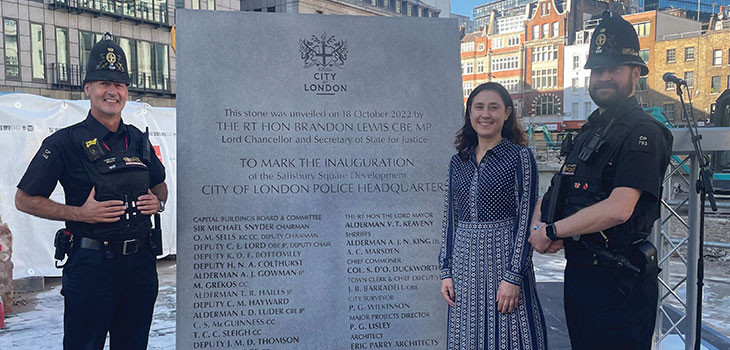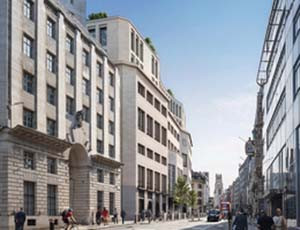*/

The construction of a state-of-the-art combined court is under way in the heart of London’s legal centre as part of Salisbury Square, a new development on Fleet Street.
Expected to open in 2026, the new City of London Law Courts will replace the ageing Mayor’s and City of London Court and the City of London Magistrates’ Court. The court will focus on high-level fraud, cyber and economic crime and contain eight Crown, six civil and four magistrates’ courtrooms. Criminal cases heard at the Old Bailey will not be affected by the scheme.
The development is designed to drive recovery and growth in the Square Mile and beyond, ensuring the City retains its global position as a hub for business, law and justice for generations to come. Upon completion, it will be home to 2,500 jobs, 400 of which will be newly created, and help the City of London Corporation meet its targets to achieve net zero across the Square Mile by 2040. Sustainability is at the core of its construction and the new court will run on clean energy sources.
I am part of the Capital Buildings Board at the City of London Corporation that is bringing this development forward in Fleet Street, which falls within the Castle Baynard ward I represent as a City of London Corporation Councillor.
It is brilliant news for my ward and the City. But what about the rest of London and the rest of England and Wales?
There are many ageing and run-down courts and continual reports of crumbling and outdated facilities due to lack of government investment. Criminal barristers have been very vocal (quite rightly) about the working conditions of such courts which are not fit for purpose. Across the country, and especially in regional areas, courts cannot be upgraded with modern technology and there are plans afoot to shut them down and sell them off.
In addition, 42 courts around the UK with listed status have been earmarked for closure due to ‘disproportionately high’ repair and modernisation costs, unless outside funding can be secured. Inner London Crown Court is a Grade II listed building and has been on the list for possible closure by the Ministry of Justice since at least 2018. Blackfriars Crown Court and Camberwell Green Magistrates’ Court were both shut down three years ago. Neither of these have been replaced by new courts.
The HMCTS Estates Strategy for 2021-31, which was published in November 2022, sets out its intentions regarding the future of the court and tribunal estate. It explains (a) how HMCTS’ four core principles – place, innovation, care and value – will be applied to decision-making in court renewal, replacement and consolidation; and (b) the specific themes examined to develop this strategy (such as changes in demand for hearing rooms; measuring the performance of buildings; ease of temporary capacity; sustainability initiatives etc).
It is quite clear from this strategy that priority for investment will be given to larger buildings. The least efficient and sustainable court buildings will be closed and work relocated, where possible, to more modern, cost effective and low energy/low carbon sites. It does not state which are the larger buildings, which courts will be closed or where new ones will be opened. Fleet Street is extremely fortunate that a new court is being developed. Note that this is wholly funded by the City of London Corporation and not HMCTS.
As much as the government says it wants to push forward a levelling up agenda, this is certainly not being applied to our court infrastructure. During the pandemic, Nightingale Courts were opened in conference centres, hotels, theatres and public buildings to keep justice going while allowing social distancing. Many of these temporary and ad hoc courts are still in operation. In February the Ministry of Justice announced that 24 Nightingale Courts are being kept open for another year. Now we have emerged from the pandemic, surely HMCTS should focus on making the best use of our existing court buildings by investing in them as well as opening new ones.
Ensuring access to justice includes improving the quality of our buildings for both professional and lay users. All courts should aspire to look and function like the new Fleet Street centre.
HMCTS needs to think creatively about how it raises funds for modernisation and expansion; not only by maximising the sale price of buildings to raise as much as possible for reinvestment but also by entering into joint venture partnerships (eg with local authorities) to bring forward new developments. After all, landmark buildings make people’s sense of pride in a place tangible. Civic pride defines and shapes our towns and cities and forms an important lens through which they are seen and governed.
We also need to remember that our court buildings reflect the value of English law on the international stage and to UK plc. English law underpins hundreds of trillions of pounds of trade and provides a platform for the financial and commercial contracts on which global business relies. Its popularity throughout the world means that UK businesses enjoy an advantage because of lower transaction costs. It is the global standard in many industries such as commodities, maritime and insurance, and there is the opportunity for it to be the standard in new and growing areas such as sustainable finance, fintech and cryptoassets.
As such, while the government, Bar Council and Law Society continue to strongly encourage the use of English law and promote England and Wales as a jurisdiction of choice and a global centre for legal services, HMCTS also needs to make sure that our court buildings showcase this too.


@CourtsIdle was originally set up to report the underuse of Crown Courts in England and Wales. Now it is a place to report on the daily failings of a system unable to cope.
The HM Courts and Tribunals Service Estates Strategy can be viewed here.

The construction of a state-of-the-art combined court is under way in the heart of London’s legal centre as part of Salisbury Square, a new development on Fleet Street.
Expected to open in 2026, the new City of London Law Courts will replace the ageing Mayor’s and City of London Court and the City of London Magistrates’ Court. The court will focus on high-level fraud, cyber and economic crime and contain eight Crown, six civil and four magistrates’ courtrooms. Criminal cases heard at the Old Bailey will not be affected by the scheme.
The development is designed to drive recovery and growth in the Square Mile and beyond, ensuring the City retains its global position as a hub for business, law and justice for generations to come. Upon completion, it will be home to 2,500 jobs, 400 of which will be newly created, and help the City of London Corporation meet its targets to achieve net zero across the Square Mile by 2040. Sustainability is at the core of its construction and the new court will run on clean energy sources.
I am part of the Capital Buildings Board at the City of London Corporation that is bringing this development forward in Fleet Street, which falls within the Castle Baynard ward I represent as a City of London Corporation Councillor.
It is brilliant news for my ward and the City. But what about the rest of London and the rest of England and Wales?
There are many ageing and run-down courts and continual reports of crumbling and outdated facilities due to lack of government investment. Criminal barristers have been very vocal (quite rightly) about the working conditions of such courts which are not fit for purpose. Across the country, and especially in regional areas, courts cannot be upgraded with modern technology and there are plans afoot to shut them down and sell them off.
In addition, 42 courts around the UK with listed status have been earmarked for closure due to ‘disproportionately high’ repair and modernisation costs, unless outside funding can be secured. Inner London Crown Court is a Grade II listed building and has been on the list for possible closure by the Ministry of Justice since at least 2018. Blackfriars Crown Court and Camberwell Green Magistrates’ Court were both shut down three years ago. Neither of these have been replaced by new courts.
The HMCTS Estates Strategy for 2021-31, which was published in November 2022, sets out its intentions regarding the future of the court and tribunal estate. It explains (a) how HMCTS’ four core principles – place, innovation, care and value – will be applied to decision-making in court renewal, replacement and consolidation; and (b) the specific themes examined to develop this strategy (such as changes in demand for hearing rooms; measuring the performance of buildings; ease of temporary capacity; sustainability initiatives etc).
It is quite clear from this strategy that priority for investment will be given to larger buildings. The least efficient and sustainable court buildings will be closed and work relocated, where possible, to more modern, cost effective and low energy/low carbon sites. It does not state which are the larger buildings, which courts will be closed or where new ones will be opened. Fleet Street is extremely fortunate that a new court is being developed. Note that this is wholly funded by the City of London Corporation and not HMCTS.
As much as the government says it wants to push forward a levelling up agenda, this is certainly not being applied to our court infrastructure. During the pandemic, Nightingale Courts were opened in conference centres, hotels, theatres and public buildings to keep justice going while allowing social distancing. Many of these temporary and ad hoc courts are still in operation. In February the Ministry of Justice announced that 24 Nightingale Courts are being kept open for another year. Now we have emerged from the pandemic, surely HMCTS should focus on making the best use of our existing court buildings by investing in them as well as opening new ones.
Ensuring access to justice includes improving the quality of our buildings for both professional and lay users. All courts should aspire to look and function like the new Fleet Street centre.
HMCTS needs to think creatively about how it raises funds for modernisation and expansion; not only by maximising the sale price of buildings to raise as much as possible for reinvestment but also by entering into joint venture partnerships (eg with local authorities) to bring forward new developments. After all, landmark buildings make people’s sense of pride in a place tangible. Civic pride defines and shapes our towns and cities and forms an important lens through which they are seen and governed.
We also need to remember that our court buildings reflect the value of English law on the international stage and to UK plc. English law underpins hundreds of trillions of pounds of trade and provides a platform for the financial and commercial contracts on which global business relies. Its popularity throughout the world means that UK businesses enjoy an advantage because of lower transaction costs. It is the global standard in many industries such as commodities, maritime and insurance, and there is the opportunity for it to be the standard in new and growing areas such as sustainable finance, fintech and cryptoassets.
As such, while the government, Bar Council and Law Society continue to strongly encourage the use of English law and promote England and Wales as a jurisdiction of choice and a global centre for legal services, HMCTS also needs to make sure that our court buildings showcase this too.


@CourtsIdle was originally set up to report the underuse of Crown Courts in England and Wales. Now it is a place to report on the daily failings of a system unable to cope.
The HM Courts and Tribunals Service Estates Strategy can be viewed here.


Chair of the Bar reflects on 2025
AlphaBiolabs has donated £500 to The Christie Charity through its Giving Back initiative, helping to support cancer care, treatment and research across Greater Manchester, Cheshire and further afield
Q&A with criminal barrister Nick Murphy, who moved to New Park Court Chambers on the North Eastern Circuit in search of a better work-life balance
Revolt Cycling in Holborn, London’s first sustainable fitness studio, invites barristers to join the revolution – turning pedal power into clean energy
Rachel Davenport, Co-founder and Director at AlphaBiolabs, reflects on how the company’s Giving Back ethos continues to make a difference to communities across the UK
By Marie Law, Director of Toxicology at AlphaBiolabs
Are you ready for the new way to do tax returns? David Southern KC explains the biggest change since HMRC launched self-assessment more than 30 years ago... and its impact on the Bar
Professor Dominic Regan and Seán Jones KC present their best buys for this holiday season
Marking one year since a Bar disciplinary tribunal dismissed all charges against her, Dr Charlotte Proudman discusses the experience, her formative years and next steps. Interview by Anthony Inglese CB
Little has changed since Burns v Burns . Cohabiting couples deserve better than to be left on the blasted heath with the existing witch’s brew for another four decades, argues Christopher Stirling
Pointillism, radical politics and social conscience. Review by Stephen Cragg KC